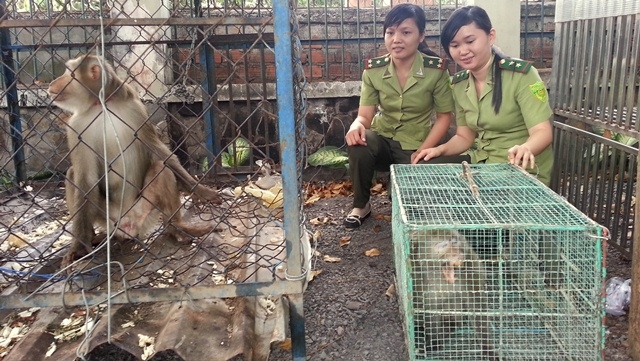Measures needed to prevent illegal wildlife trade
Despite tighter wildlife trade management, the complex development of an illegal wildlife trade requires strengthened efforts from the whole society to preserve biodiversity.
 |
| Binh Duong Provincial Forest Protection Department receives captive wild monkeys voluntarily handed over by locals to release to the wild. (Credit: sonongnghiep.binhduong.gov.vn) |
Vietnamese authorities have uncovered dozens of illegal wildlife trade cases since 2011. From 2016 until now, Viet Nam has seized more than seven tonnes of ivory, over 150 kg of rhino horns, more than two tonnes of pangolin scales, and many other specimens of wild animals.
According to the Viet Nam Forest Protection Department, although the number of violations in wildlife trading, transport and consumption decreased from 459 in 2014 to 295 in 2015 and 256 in 2016, the crime in this area is still complicated, as criminals choose Viet Nam as a transit point on all three routes of sea, road and air.
In addition, criminals often use social networks such as Facebook, Zalo or Wechat to carry out illegal wildlife trade activities, making it difficult for authorities.
Meanwhile, the handling of illegal trade and transportation of wildlife specimens and wild animals by competent authorities merely stops at confiscation and processing of administrative violations. Criminal prosecution and handling has not been implemented due to a bottleneck in the provisions of the 1999 Penal Code (revised 2009), while the new 2015 Penal Code has not yet taken effect.
In 2017, the world is taking strong and sustained action to close illegal wildlife trade markets and reduce demand for wildlife products. To prevent this crime, which is also a manifestation of Viet Nam's commitment when it joined the Convention on International Trade in Endangered Species of Wild Fauna and Flora (CITES), as well as bilateral and multilateral agreements and UN Resolutions on combating illegal trade of wild fauna and flora species, on September 17, 2016, the Prime Minister issued Directive No. 28/CT-TTg on urgent solutions to prevent and combat illegal acts affecting wild animals.
Through this, functional agencies should organise communication campaigns and dissemination of information to citizens and civil servants, especially law enforcement forces, on the war for protection of wild fauna and flora species, while coordinating with international organisations on transnational wildlife trade lines.
In addition, regular patrols should be held to collect information and firmly control the situation in localities with an illegal wildlife trade, as well as closely supervising wild fauna and flora products to set up specialists to fight and thoroughly handle violations, especially control of trade and prosecution of outstanding cases involving ivory and rhino horn trade.
Along with that is the requirement to effectively strengthen enforcement of the law, even to replace, amend and supplement some relevant laws, especially the 2015 Penal Code, as well as developing solutions to create decent jobs for those involving in legally raising and trading wild animals and plants in Viet Nam.
(Source: NDO)